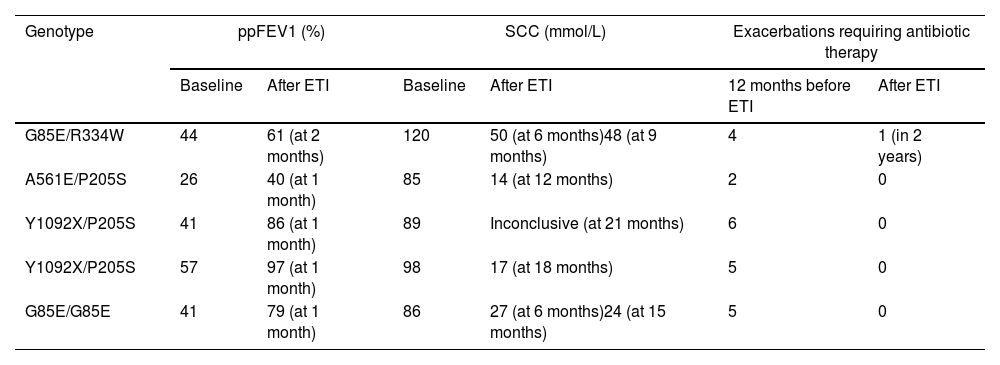The benefits of elexacaftor-tezacaftor-ivacaftor (ETI) for people with cystic fibrosis (pwCF) with one or two F508del alleles are evident in clinical trials and recent real-life studies.1-3 In the United States (US), but not in Europe, ETI is also approved for other mutations with in vitro responsiveness.4 Clinical efficacy in non-F508del mutations was described in a retrospective review of 16 patients and an observational study of 84 patients with advanced lung disease.5,6 We report our experience with off-label ETI use in five Portuguese pwCF with non-F508del mutations.
A 29-year-old female pwCF was diagnosed at 13 years old with sweat chloride concentration (SCC) of 120 mmol/L and G85E/R334W genotype. She experienced daily sputum, several exacerbations per year, and hemoptysis requiring bronchial artery embolization twice. She had chronic Pseudomonas aeruginosa infection since the age of 24, and her respiratory microbiome also included methicillin-sensitive Staphylococcus aureus (MSSA), Haemophilus influenzae, Achromobacter xyloxidans and Aspergillus fumigatus. Percentage of predicted FEV1 (ppFEV1) declined from 92 to 44% over nine years, and off-label ETI was started at the age of 27. Two months later, she reported sputum reduction, hemoptysis cessation, a 5 kg weight gain, and ppFEV1 improved to 61%. SCC after three and nine months was 50 and 48 mmol/L, respectively. No adverse effects occurred. After two years, she suffered a single exacerbation.
A 30-year-old male pwCF, diagnosed at 25 months of age, with SCC of 85 mmol/L and A561E/P205S genotype, presented with daily sputum, several exacerbations per year, and chronic infection by P. aeruginosa and MSSA. Over five years, ppFEV1 declined from 42 to 26%, and at 28 years old he began ambulatory oxygen therapy and was referred to lung transplantation. Off-label ETI was started, but interrupted for 10 days due to a skin rash. No additional adverse effects occurred after gradual reinstatement. After one month, he reported sputum reduction and a 7 kg weight gain. ppFEV1 increased to 40%, allowing postponement of lung transplantation. SCC after one year was 14 mmol/L, and after two years he is asymptomatic and without exacerbations.
Two 19-year-old female monozygotic twins, A and B, were diagnosed at five years old, with Y1092X/P205S genotype and SCC of 89 and 98 mmol/L, respectively. Both presented daily sputum and frequent exacerbations. Their respiratory microbiome included H. influenzae and MSSA, but Twin B also had chronic P. aeruginosa infection since the age of 17. At this age, both twins were treated for allergic bronchopulmonary aspergillosis. At 18 years old, ppFEV1 declined to 41% (A) and 57% (B). Since previously performed ex vivo studies showed responsiveness to tezacaftor-ivacaftor, Twin A started off-label ETI at that age, and Twin B followed three months later. On the first days, they purged large amounts of sputum, with reduction thereafter. ppFEV1 increased dramatically after one month, to 86% (A) and 97% (B). No adverse effects occurred. To date, both twins report sputum disappearance and no further exacerbations. Twin B's SCC after 18 months of ETI was 17 mmol/L; Twin A's sweat test after 21 months was inconclusive due to an insufficient sample.
Lastly, an 18-year-old female pwCF, diagnosed at 13 months of age (SCC of 86 mmol/L and G85E/G85E genotype), presented with daily sputum and recurrent infections. Chronic infection by P. aeruginosa and methicillin-resistant S. aureus (MRSA) developed at 15 years old, and her respiratory microbiome also included H. influenzae. At the age of 16, ppFEV1 dropped from 71 to 41%, and she developed cystic fibrosis related diabetes (CFRD). ETI was started at that age, following positive ex vivo studies. After just four days, there was sputum reduction and ppFEV1 recovery to 72%. She experienced acute gastritis on the third week, but improved with pharmacological treatment and ETI was not interrupted. ppFEV1 after one month improved to 79%, and CFRD resolved completely after three months. SCC at six and 15 months was 27 and 24 mmol/L, respectively. To date, after 18 months of treatment, no further exacerbations occurred, despite persistent chronic MRSA infection.
All patients carried at least one G85E or P205S allele, both approved for ETI use in the US, and all had improvement in symptoms and exacerbation frequency. ppFEV1 improvement ranged from 14 to 45%, with more modest gains in the first and second patients, possibly due to older age and more advanced lung disease. Available SCC data showed normalization in three patients and a drop to intermediate levels in another. Treatment was temporarily interrupted in only one patient, due to a mild adverse effect. Table 1 summarizes patient characteristics before and after treatment.
Patient characteristics before and after treatment with elexacaftor-tezacaftor-ivacaftor.
ppFEV1: percentage of predicted FEV1. SCC: sweat chloride concentration. ETI: elexacaftor-tezacaftor-ivacaftor.
Three variants absent from the eligibility list (A561E, R334W and Y1092X) were present in heterozygosity. Y1092X is a nonsense mutation and not expected to be responsive. There is evidence of in vitro R334W rescue by ETI,7 and although A561E seems susceptible to in vitro potentiation by ivacaftor,8 its processing defect is apparently not corrected by elexacaftor/tezacaftor.9 Notably, in the French compassionate programme, half of ETI clinical responders carried mutations not currently approved in the US, including two patients carrying R334W and one carrying A561E in heterozygosity with nonsense mutations.6 However, in our patients, due to the presence of G85E and P205S alleles (both with known ETI response), the clinical benefit cannot be attributed to the rescue of either A561E or R334W.
Ex vivo Ussing chamber studies of nasal cells and forskolin-induced swelling assays of intestinal organoids were performed in both Y1092X/P205S twins and in the G85E/G85E pwCF, showing significant positive responses to tezacaftor/ivacaftor in the twins and to ETI in the G85E homozygote. These studies can predict clinical response and allow individualized treatment of patients with rarer variants.10
To conclude, off-label ETI treatment was effective and relatively safe in five pwCF carrying at least one G85E or P205S allele, both approved for ETI use in the US, but not yet in our European setting.








